NCERT Solutions for Class 8 Maths Chapter 9 - Mensuration - 1 (Exercise 9.1)
Exercise 9.1
Q1. The shape of the top surface of a table is a trapezium. Find its area if its parallel sides are 1 m and 1.2 m and perpendicular distance between them is 0.8 m.
Ans: Area of the trapezium 1/2 × (a + b) × h
1/2 × (1.2 + 1) × 0.8
1/2 × 2.2 × 0.8
= 0.88 m2
Hence, the required area = 0.88 m2
Q2. The area of a trapezium is 34 cm2 and the length of one of the parallel sides is 10 cm and its height is 4 cm. Find the length of the other parallel sides.
Ans: Given: Area of trapezium = 34 cm2
Length of one of the parallel sides a = 10 cm
height h = 4 cm
Area of the trapezium = 1/2 × (a + b) × h
34 = 1/2 × (10 + b) × 4
⇒ 34 = (10 + b) × 2
⇒ 17 = 10 + b
⇒ b = 17 – 10 = 7 cm
Hence, the required length = 7 cm.
Q3. Length of the fence of a trapezium shaped field ABCD is 120 m. If BC = 48 m, CD = 17 m and AD = 40 m, find the area of this field. Side AB is perpendicular to the parallel sides AD and BC.
Ans: Length of the fence = Perimeter
∴ AB + BC + CD + DA = 120
or AB + 48 + 17 + 40 = 120
or AB + 105 = 120
or AB = 120 – 105 = 15 m
∵ Area of a trapezium = 1/2 * [Sum of parallel sides] * Height
= 1/2 × (AD + BC) × AB
= 1/2 × (40 + 48) × 15 M2
= 1/2 × 88 × 15 M2
= 44 × 15 M2 = 660 M2
Q4. The diagonal of a quadrilateral shaped field is 24 m and the perpendiculars dropped on it from the remaining opposite vertices are 8 m and 13 m. Find the area of the field.
Ans: Area of the field = area of ∆ABD + area of ∆BCD

= 1/2 × b × h + 1/2 × b × h
= 1/2 × 24 × 13 + 1/2 × 24 × 8
= 12 × 13 + 12 × 8
= 12 × (13 + 8)
= 12 × 21
= 252 m2
Hence, the required area of the field = 252 m2.
Q5. The diagonals of a rhombus are 7.5 cm and 12 cm. Find its area.
Ans: Given: d1 =7.5 cm and d2 = 12 cm
Area of the rhombus = 1/2 × d1 × d2
= 1/2 × 7.5 × 12
= 7.5 × 6
= 45 cm2
Hence, area of the rhombus = 45 cm2.
Q6. Find the area of a rhombus whose side is 5 cm and whose altitude is 4.8 cm. If one of its diagonals is 8 cm long, find the length of the other diagonal.
Ans: Given: Side = 5 cm
Altitude = 4.8 cm
Length of one diagonal = 8 cm
Area of the rhombus = Side × Altitude = 5 × 4.8 = 24 cm2
Area of the rhombus = 1/2 × d1 × d2
24 = 1/2 × d1 × d2
24 = 4d2
d2 = 6 cm
Hence, the length of other diagonal = 6 cm.
Q7. The floor of a building consists of 3000 tiles which are rhombus shaped and each of its diagonals are 45 cm and 30 cm in length. Find the total cost of polishing the floor, if the cost per m2 is ₹ 4.
Ans: Given: Number of tiles = 3000
Length of the two diagonals of a tile = 45 cm and 30 cm
Area of one tile = 1/2 × d1 × d2
= 1/2 × 45 × 30
= 45 × 15
= 675 cm2
Area covered by 3000 tiles = 3000 × 675 cm2 = 2025000 cm2 = 202.5 m2
Cost of polishing the floor = 202.5 × 4 = ₹ 810
Hence, the required cost = ₹ 810.
Q8. Mohan wants to buy a trapezium shaped field. Its side along the river is parallel to and twice the side along the road. If the area of this field is 10500 m2 and the perpendicular distance between the two parallel sides is 100 m, find the length of the side along the river.
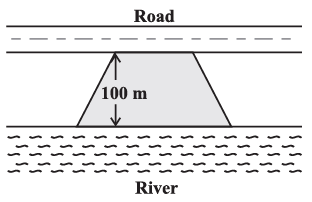
Ans: Perpendicular distance (h) = 100 m (Given)
Area of the trapezium-shaped field = 10500 m2 (Given)
Let the side along the road be ‘x’ m and the side along the river = 2x m
Area of the trapezium field = (1/2)×(a + b) × h
10500 = (1/2) × (x + 2x) × 100
10500 = 3x × 50
After simplifying, we have x = 70, which means the side along the river is 70 m
Hence, the side along the river = 2x = 2(70) = 140 m.
Q9. Top surface of a raised platform is in the shape of a regular octagon as shown in the figure. Find the area of the octagonal surface.

Ans: This regular octagon can be into two trapeziums (each having height 4 m and parallel sides as 11 m and 5 m) and a rectangular part with length 11 m and breadth 5 m.
Area of a trapezium
= 1/2 [11m + 5m] × 4m
= 1/2 × 16 × 4m2 = 32m2
∴ Area of both the trapeziums = 2 × 32 m2 = 64 m2
Now, Area of the rectangular part = l * b
= 11 m × 5 m = 55 m2
∴ Area of the regular octagon = 64 m2 + 55 m2 = 119 m2
Q10. There is a pentagonal shaped park as shown in the figure. For finding its area Jyoti and Kavita divided it in two different ways.
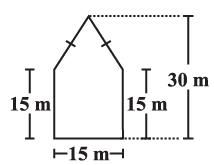
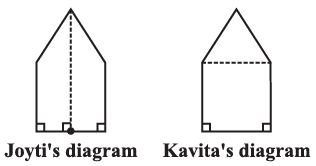
Find the area of this park using both ways. Can you suggest some other way of finding its area?
Ans: Jyoti’s diagram: The given shape is splitted into two congruent trapeziums.
Area of one trapezium
= 1/2 × [15 + 30] × 15/2 m2
= 1/2 × 45 × 15/2 m2
= 675/4 m2
∴ Area of the pentagonal shape = 2 × 675/4 m2 = 675/2 m2 = 337.5 m2
Kavita’s diagram:
The given shape is splitted into a square and a triangle.
Area of the square = 15 m × 15 m = 225 m2
Area of the triangle = 1/2 × 15 × 15 =225/2 m2 = 112.5 m2
∴ Area of the pentagonal shape = 112.5 + 225 = 337.5 m2
Another way of finding the area of the pentagonal shape:
By splitting the pentagonal shape into 3 triangles, we have:
Area of triangle I = 1/2 × 15 × 15m2 = 225/2 m2
Area of triangle II = 1/2 × 15 × 15m2 = 225/2 m2
Area of triangle III = 1/2 × 15 × 15m2 = 225/2 m2
∴ Area of the pentagonal shape = 225/2 m2 + 225/2 m2 + 225/2 m2 = 337.5 m2
Q11. Diagram of the adjacent picture frame has outer dimensions = 24 cm × 28 cm and inner dimensions 16 cm × 20 cm. Find the area of each section of the frame, if the width of each section is same.
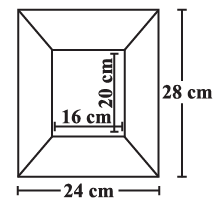 Ans: Divide given figure into 4 parts, as shown below:
Ans: Divide given figure into 4 parts, as shown below: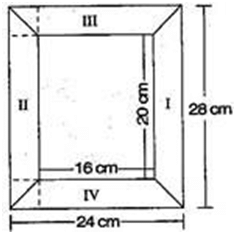 Here two of the given figures (I) and (II) are similar in dimensions.And also, figures (III) and (IV) are similar in dimensions.
Here two of the given figures (I) and (II) are similar in dimensions.And also, figures (III) and (IV) are similar in dimensions.
Area of figure (I) = Area of trapezium
= 1/2 × (a + b) × h
= 1/2 × (28 + 20) × 4
= 1/2 × 48 × 4 = 96
Area of figure (I) = 96 cm2
Also, Area of figure (II) = 96 cm2
Now, Area of figure (III) = Area of trapezium
= 1/2 × (a + b) × h
= 1/2 × (24 + 16)4
= 1/2 × 40 × 4 = 80
Area of figure (III) is 80 cm2
Also, Area of figure (IV) = 80 cm2
Exercise - 9.2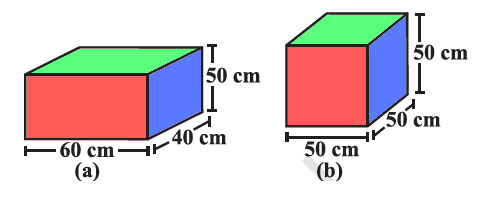
1. There are two cuboidal boxes as shown in the adjoining figure. Which box requires the lesser amount of material to make?
Solution :- To determine which box requires less material, we are going to compare their surface areas.
For the first cuboidal box, given –
Length(l) = 60 cm
Breadth (b) = 40 cm
Height (h) = 50 cm
Total surface area of a cuboid = 2(lb + bh + hl)
2(60 × 40 + 40 × 50 + 50 × 60) (putting the value of l, b, h in the formula)
= 2(2400 + 2000 + 3000)
= 2 × 7400 = 14800 cm²
For the second cuboidal box, given –
Length(l) = 50 cm
Breadth (b) = 50 cm
Height (h) = 50 cm
Total surface area of a cuboid = 2(lb + bh + hl)
2(50 × 50 + 50 × 50 + 50 × 50) (putting the value of l, b, h in the formula)
= 2(2500 + 2500 + 2500)
= 2 × 7500 = 15000 cm²
The total surface area of the cuboidal box (a) is less, cuboidal box (a) would require less material to make. (Box with the smaller surface area requires less material.)
2. A suitcase with measures 80 cm × 48 cm × 24 cm is to be covered with a tarpaulin cloth. How many metres of tarpaulin of width 96 cm is required to cover 100 such suitcases?
Solution :- For the suitcase, given –
Length(l) = 80 cm
Breadth (b) = 48 cm
Height (h) = 24 cm
Total surface area of a cuboid = 2(lb + bh + hl)
Surface area of one suitcase = 2(80 × 48 + 48 × 24 + 24 × 80) cm²
= 2(3840 + 1152 + 1920)
= 2 × 6912
= 13824 cm²
To cover 1 suitcase, area of tarpaulin cloth required will be = 13824 cm²
Given, width of the tarpaulin cloth = 96 cm
Area of tarpaulin cloth required to cover 1 suitcase = Total surface area of the suitcase
Area of tarpaulin cloth required to cover 1 suitcase = 13824 cm²
=) Length × Width = 13824 (since tarpaulin is in the form of rectange. Area of Rectangle = Length × Width)
=) Length × 96 = 13824
=) Length = 13824/96
= 144 cm
Length of tarpaulin cloth required to cover 100 suitcases = 100 × 144
= 144000 cm
= 144000/100 (converting centimeter to meter by dividing with 100)
= 144 m
A total of 144 m of tarpaulin cloth with width of 96 cm is required to cover 100 suitcases.
3. Find the side of a cube whose surface area is 600 cm².
Solution :- Total surface area of a cube = 6 × side².
Given, total surface area of the cube is 600 cm²
600 cm² = 6 × side².
side² = 600/6
Solving for side, side = √(600/6)
= √100
= 10 cm
4. Rukhsar painted the outside of the cabinet of measure 1 m × 2 m × 1.5 m. How much surface area did she cover if she painted all except the bottom of the cabinet.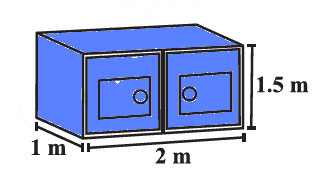 Solution :- Given the dimensions of the cabinet –
Solution :- Given the dimensions of the cabinet –
Length(l) = 1 m
Breadth (b) = 2 m
Height (h) = 1.5 m
The surface area of the painted cabinet = Total surface area of the cabinet – Area of the bottom
= 2(lb + bh + hl) – lb
= lb + 2bh + 2hl
= 2(1 × 2 + 2 × 2 × 1.5 + 2 × 1.5 × 1)
= (2 + 6 + 3) m²
= 11 m²
Area of cabinet she covers is 11 m²
5. Daniel is painting the walls and ceiling of a cuboidal hall with length breadth and height of 15 m, 10 m, and 7 m respectively. From each can of paint 100 m² of area is painted. How many cans of paint will he need to paint the room?
Solution :- Given the dimensions of the wall –
Length(l) = 15 m
Breadth (b) = 10 m
Height (h) = 7 m
Surface area of walls and ceiling to be painted = 2h(l + b) + l × b
= 2 × 7(15 + 10) + 15 × 10
= 2 × 7 × 25 + 150
= 350 + 150
= 500 m²
Each can can paint and area of 100 m²
Number of cans required for painting = Area to be painted/Area painted by 1 can
= 500 m²/100 m²
= 5
Daniel require 5 cans of paint to paint the hall
6. Describe how the two figures at the right are alike and how they are different. Which box has larger lateral surface area? Solution :- Similarities:
Solution :- Similarities:
– Both figures have the same height of 7 cm.
– The diameter of the cylinder and the side length of the cube are both 7 cm.
Differences:
– The cylinder has a circular base while the cube has a square base.
– The cylinder’s lateral surface is curved while the cube’s lateral surface consists of four flat squares.
For the cylinder –
Diameter = 7 cm
Radius(r) = Diameter/2
= 7/2 cm
Height = 7 cm
Lateral Surface Area of the cube = 4 × side²
= 4 × (7 cm × 7 cm)
= 196 cm².
Curbed lateral Surface Area of the cylinder = 2πr × h
= 2 × 22/7 × 7/2 cm × 7 cm
= 154 cm².
The cube(2nd figure) has a larger lateral surface area than the cylinder.
7. A closed cylindrical tank of radius 7 m and height 3 m is made from a sheet of metal. How much sheet of metal is required?
Solution :- The surface area of a cylinder includes the areas of its two circular ends and its lateral surface.
Surface area = 2πr² (ends) + 2πrh (lateral surface).
Given, for radius of the cylinder(r) = 7 m and Height (h) = 3 m:
Surface area = 2 × 22/7 × 7² + 2 × 22/7 × 7 × 3
= 2 × 22 × 7 + 2 × 22 × 3
= 308 + 132
= 440 m²
440 m² sheet of metal is required to build a closed cylindrical tank
8. The lateral surface area of a hollow cylinder is 4224 cm². It is cut along its height and formed a rectangular sheet of width 33 cm. Find the perimeter of the rectangular sheet?
Solution :- When we cut the hollow cylinder along its height, we get a rectangular sheet of width 33 cm. This is height of the cylinder.
Here we can assume radius of the hollow cylinder be r
Lateral surface area of the cylinder = length of the rectangle × width of the rectangle.
For a lateral surface area of 4224 cm² and a width of 33 cm:
Lateral surface area of the cylinder = 2πrh
4224 = 2πrh (since, Lateral surface area = 4224)
2 × 22/7 × r × 33 = 4224
r = 4224 × 7/(2 × 22 × 33)
= (7 × 96)/33
= (7 × 33)/11
= 21 cm
On cutting the hollow cylinder, the base’s perimeter is equal to length of rectangular sheet
Length of the rectangle = Perimeter of circular base
Perimeter of circular base = 2πr
= 2 × 22/7 × 21
= 128 cm.
Perimeter of the rectangle = 2 × (length + width)
= 2 × (128 cm + 33 cm) = 2 × 161 cm = 322 cm
The perimeter of rectangular sheet is 322 cm
9. A road roller takes 750 complete revolutions to move once over to level a road. Find the area of the road if the diameter of a road roller is 84 cm and length is 1 m.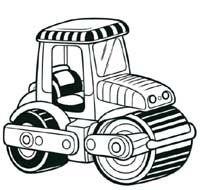
Hint: The road roller is in the shape of a cylinder. The area covered by the roller will be equal to curved surface area of the roller.
Solution :- Given –
Length of the roller = 1 m = 100 cm
Diameter of road roller = 84 cm
Radius of road roller = 84/2 = 42 cm
Curved surface area of the cylinder = 2πrh
= 2 × 22/7 × 42 × 100
= 26400 cm²
Area covered by the road roller in one revolution = Curved surface area of the roller
= 26400 cm² (lets conver it to m²)
= 26400/(100 × 100)
= 2.64 m²
Area covered by road roller in 750 revolutions = 750 × 2.64
= 1980 m² is the required area of the road
10. A company packages its milk powder in cylindrical container whose base has a diameter of 14 cm and height 20 cm. Company places a label around the surface of the container (as shown in the figure). If the label is placed 2 cm from top and bottom what is the area of the label.
Solution :- The label covers the lateral surface area of the cylinder, minus the top and bottom 2 cm.
Radius of the cylinder, r = 14/2 cm = 7 cm.
Effective height of the label, h = 20 cm – 2 cm – 2 cm = 16 cm.
Lateral surface area for the label = 2πrh = 2 × π × 7 cm × 16 cm = 2 × 3.14 × 7 × 16 cm² = 704 cm².
Therefore, the area of the label is 704 cm².
Exercise - 9. 3
1. Given a cylindrical tank, in which situation will you find surface area and in which situation volume.
(a) To find how much it can hold.
Volume (because volume measures the capacity of the tank).
(b) Number of cement bags required to plaster it.
Surface Area (because plastering involves covering the surface).
(c) To find the number of smaller tanks that can be filled with water from it.
Volume (as it’s a matter of the tank’s capacity).
2. Diameter of cylinder A is 7 cm, and the height is 14 cm. Diameter of cylinder B is 14 cm and height is 7 cm. Without doing any calculations can you suggest whose volume is greater? Verify it by finding the volume of both the cylinders. Check whether the cylinder with greater volume also has greater surface area?
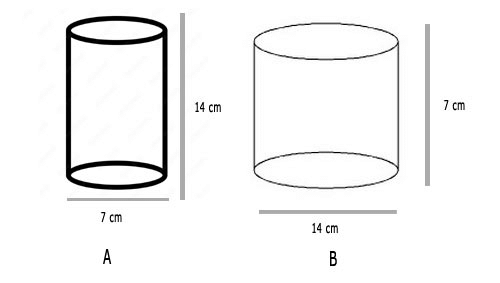
Since the diameter of cylinder B is greater(double) than that of A, we can say that the volume of the cylinder B will be greater without performing any calculations.
Let’s verify this by calculating the volume of both cylinders:
For cylinder A:
Radius r = diameter / 2 = 7 cm / 2 = 3.5 cm
Height of cylinder A: h = 14 cm
Volume V = π * r² * h = (22/7) * (3.5 cm)² * 14 cm
Volume V = (22/7) * 12.25 cm² * 14 cm
Volume V = 22 * 12.25 cm² * 2 cm (dividing numerator 14 by denominator 7)
Volume V = 539 cm³
For cylinder B:
Radius r = diameter / 2 = 14 cm / 2 = 7 cm
Height of cylinder B: h = 7 cm
Volume V = π * r² * h = (22/7) * (7 cm)² * 7 cm
Volume V = (22/7) * 49 cm² * 7 cm
Volume V = 22 * 7 cm * 7 cm
Volume V = 1078 cm³
From the calculation, we have verified that the volume of the cylinder B is greater.
Surface area comparison:
For cylinder A:
Surface area A = 2 * π * r (h + r)
A = 2 * (22/7) * 3.5 cm (14 + 3.5)
A = 22 *(28 + 7)/2
A = (22 * 35)/2
A = 385 cm²
For cylinder B:
Surface area A = 2 * π * r (h + r)
A = 2 * (22/7) * 7 cm (7 + 7)
A = 2 * (22/7) * 7 cm (14)
A = 44 * 14
A = 616 cm²
Cylinder B has a greater surface area of 616 cm² compared to cylinder A’s surface area of 385 cm².
Question 3: Find the height of a cuboid whose base area is 180 cm² and volume is 900 cm³.
Formula for volume of a cuboid: Volume = Base Area × Height
Given: Volume = 900 cm³, Base Area = 180 cm²
Volume = Base Area × Height
Height = Volume / Base Area
Height = 900 cm³ / 180 cm² = 5 cm
The height of cuboid is 5 cm
Question 4: A cuboid is of dimensions 60 cm × 54 cm × 30 cm. How many small cubes with side 6 cm can be placed in the given cuboid?
Given, dimensions of cuboid = 60 cm × 54 cm × 30 cm
Length = 60 cm
Width = 54 cm
Height = 30 cm
Formula for volume of the cuboid = Length × Width × Height
= 60 cm × 54 cm × 30 cm = 97200 cm³
Given side of small cube is 6 cm
Volume of a small cube = Side³
= 6 cm × 6 cm × 6 cm = 216 cm³
Since small cubes are placed in the given cuboid –
Number of small cubes = Volume of the cuboid / Volume of a cube
= 97200 cm³ / 216 cm³ = 450
Question 5: Find the height of the cylinder whose volume is 1.54 m³ and diameter of the base is 140 cm.
Radius of the base = Diameter / 2
= 140 cm / 2 = 70 cm = 0.7 m (since 1m = 100cm)
Formula for volume of a cylinder: Volume = π × r² × Height
Given: Volume = 1.54 m³, r = 0.7 m
Height = Volume / (π × r²)
= 1.54 m³ / (π × 0.7 m × 0.7 m)
Height = 1 m (using π = 3.14)
Question 6: A milk tank is in the form of a cylinder whose radius is 1.5 m and length is 7 m. Find the quantity of milk in liters that can be stored in the tank.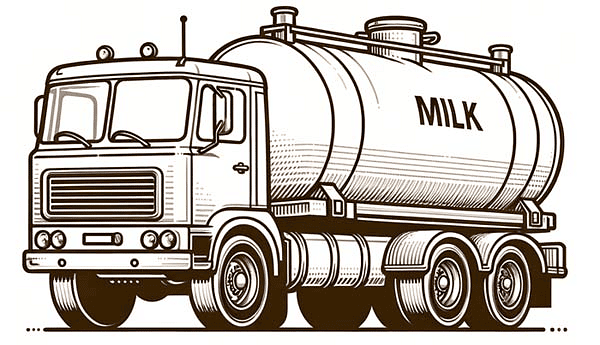
Radius of the cylindrical tank = 1.5 m (given)
Height of the cylindrical tank = 7m
Formula for volume of a cylinder: Volume = π × r² × Height
Given: r = 1.5 m, Height (length of the tank) = 7 m
Volume = π × 1.5 m × 1.5 m × 7 m
Volume = (22/7) × 1.5 m × 1.5 m × 7 m
Volume = 49.5 m³ (using π = 22/7)
Since 1 m³ = 1000 L
Volume = 49.5 * 1000
= 49500 L
Question 7: If each edge of a cube is doubled, (i) how many times will its surface area increase? (ii) how many times will its volume increase?
(i) Increase in Surface Area:The formula for the surface area of a cube is 6 × (edge length)². Let’s say the original edge length is ‘a’. So, the original surface area is 6a².
When the edge length is doubled, the new edge length becomes 2a. The new surface area is then 6 × (2a)² = 6 × 4a² = 24a².
To find how many times the surface area increases, we divide the new surface area by the original surface area.
So, it increases by a factor of 24a² / 6a² = 4 times.
(ii) Increase in Volume:
The formula for the volume of a cube is (edge length)³. The original volume is a³.
When the edge length is doubled to 2a, the new volume becomes (2a)³ = 8a³.
To find how many times the volume increases, we divide the new volume by the original volume.
So, it increases by a factor of 8a³ / a³ = 8 times.
Question 8: Water is pouring into a cuboidal reservoir at the rate of 60 litres per minute. If the volume of reservoir is 108 m3, find the number of hours it will take to fill the reservoir. Finding the Time to Fill the Reservoir:
Finding the Time to Fill the Reservoir:
We are given the rate of water flow as 60 liters per minute and the volume of the reservoir as 108 m³.
First, we need to convert the volume of the reservoir from cubic meters to liters, because the flow rate is in liters. 1 m³ = 1000 liters.
So, the volume of the reservoir is 108 × 1000 = 108,000 liters.
Now, we find the time taken to fill the reservoir. Time = Volume / Rate.
So, the time taken to fill the reservoir is 108,000 liters / 60 liters per minute = 1800 minutes.
To convert minutes into hours, we divide by 60. Thus, 1800 minutes / 60 = 30 hours.
So, it will take 30 hours to fill the reservoir.
|
87 videos|455 docs|31 tests
|
FAQs on NCERT Solutions for Class 8 Maths Chapter 9 - Mensuration - 1 (Exercise 9.1)
| 1. What are the basic concepts of mensuration? |  |
| 2. How is mensuration used in real life? |  |
| 3. What is the difference between perimeter and area? |  |
| 4. How do you calculate the volume of a three-dimensional shape? |  |
| 5. Why is mensuration important in mathematics? |  |

















